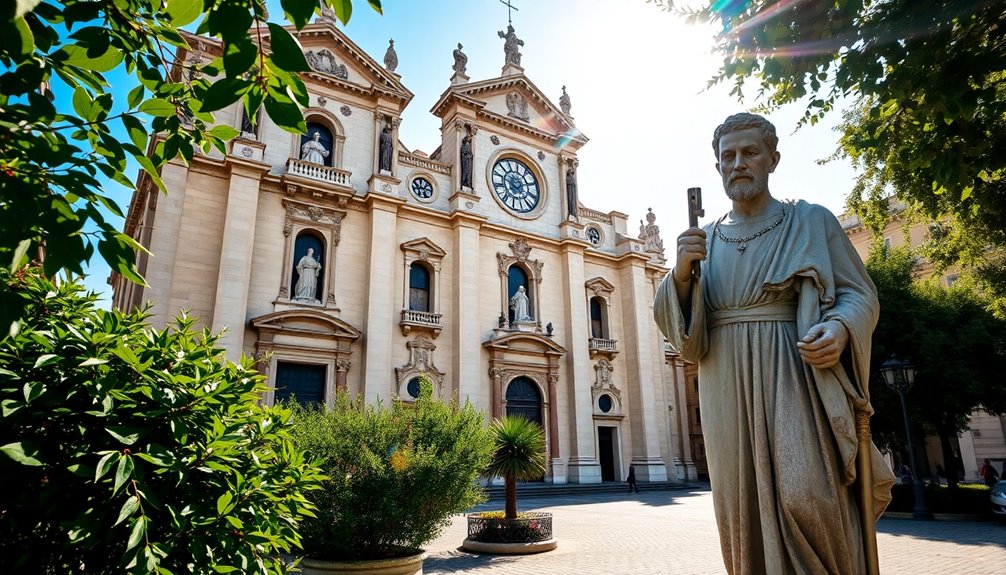When you think of Jesus in the manger, you see a powerful symbol of humility and accessibility. His birth in a modest setting reflects the socio-economic realities of first-century Bethlehem, where Mary and Joseph struggled. This manger signifies Jesus as the "Bread of Life," offering spiritual nourishment to all. The presence of shepherds after the angel's announcement emphasizes that His message is for everyone, especially the marginalized. Each nativity scene invites you to reflect on the simplicity of His arrival and the love it represents. If you'd like to explore more about this significant event and its impact, there's so much more to uncover.
Key Takeaways
- Jesus was born in a manger, symbolizing humility and accessibility, reflecting His mission to provide spiritual nourishment as the "Bread of Life."
- The manger's rustic setting emphasizes Jesus' identification with the marginalized and the socio-economic realities of first-century Bethlehem.
- Scriptural accounts, particularly Luke 2:7, highlight the significance of Jesus' humble beginnings and the fulfillment of Old Testament prophecies.
- Nativity scenes, popularized by St. Francis of Assisi, serve to educate and inspire reflection on Jesus' incarnation and divine love during Christmas.
- Common misconceptions about the nativity include the nature of the "inn," the presence of animals, and the number of wise men visiting Jesus.
Introduction
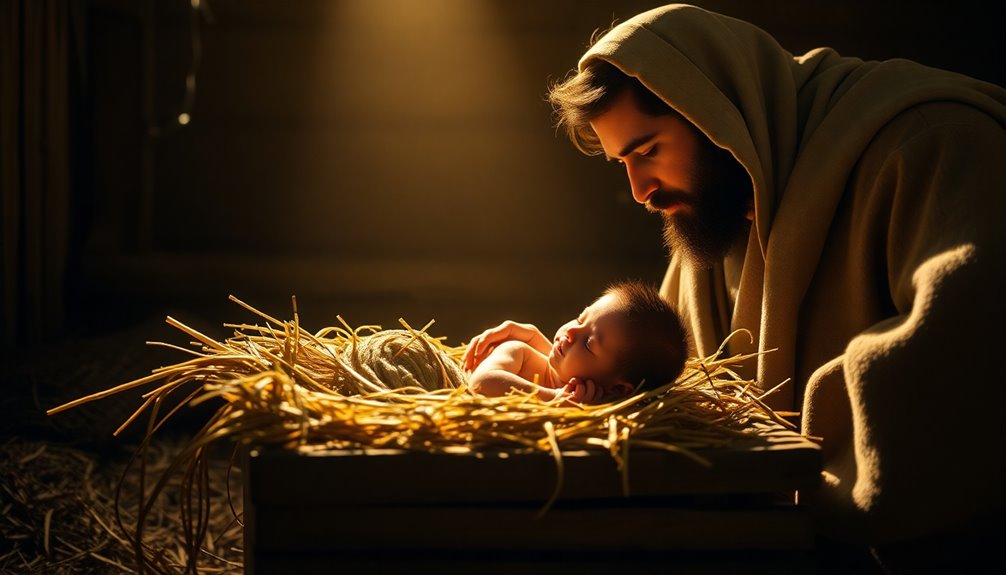
As you explore the story of Jesus' birth, you'll find that His arrival in a manger reveals profound truths about humility and accessibility. Born in Bethlehem, Jesus was laid in a feeding trough, demonstrating the simplicity of His beginnings.
This setting, chosen by Mary and Joseph, wasn't just a random choice; it reflected their humility and the circumstances surrounding His birth. Opting for a manger filled with hay over a cold stone floor, they made the best of a humble situation.
The term "manger" itself comes from the Latin word "manducare," meaning "to eat," which highlights its role as a source of nourishment. This symbolism deepens when you consider Jesus as the "Bread of Life."
In the nativity, the manger stands as a powerful reminder of Jesus' mission to provide spiritual nourishment to all believers.
Every time you gaze upon nativity scenes featuring the manger, you're invited to reflect on the accessible nature of Jesus' arrival. He came into the world not in grandeur but in a way that emphasizes His role as sustenance for the soul, inviting everyone to partake in His life-giving presence.
Scriptural Insights on the Manger

In examining the manger, you'll find key Bible references that illuminate its significance. Luke 2:7 and Luke 2:12 highlight the humble setting of Jesus' birth and the angel's announcement to the shepherds.
Additionally, exploring secondary references, like those in John 6:35 and Micah 5:2, reveals deeper layers of meaning tied to Jesus' identity and mission.
Primary Bible References
Highlighting the significance of Jesus' birth, Luke 2:7 clearly states that Mary laid Him in a manger due to a lack of room at the inn. This humble setting marks the Nativity story, emphasizing Jesus' humble beginnings as He was born not in a palace but in a feeding trough.
The Gospel of Luke further illustrates this moment when an angel told the shepherds to find the baby wrapped in swaddling cloths and lying in a manger (Luke 2:12). The manger symbolizes accessibility, showing that Jesus came for everyone, regardless of status.
Moreover, His birth in this lowly place fulfills Old Testament prophecies about the Messiah, contrasting with the expectations of earthly grandeur. Instead of a royal cradle, the Savior of the world was laid in a manger, reflecting a divine plan that highlights humility and grace.
This scene in the city of David underscores the significance of Jesus' arrival, inviting all to witness the miracle of His incarnation. As you reflect on these primary Bible references, consider how they reveal the profound message of hope and salvation that began in that simple manger.
Secondary Bible References
The manger not only signifies Jesus' humble beginnings but also resonates with deeper spiritual truths found throughout Scripture. The Gospel of Luke (2:7) tells us that Jesus was laid in a manger because there was no room in the inn, highlighting the humility surrounding His birth. This feeding trough symbolizes Jesus as the "Bread of Life" (John 6:35), underscoring His role as spiritual sustenance for humanity.
When the angel announced His birth to the shepherds, he provided a sign: they'd find the baby wrapped in swaddling cloths and lying in a manger (Luke 2:12). This detail reinforces the theme of humility in Jesus' arrival.
Furthermore, His birth in Bethlehem fulfills the Old Testament prophecy in Micah 5:2, which foretells the Messiah's humble origins.
The manger serves as a vivid reminder of God's accessibility to all people, illustrating that the Savior of the world was born in the simplest of settings. This divine humility invites you to recognize that greatness can emerge from the most unassuming beginnings, encouraging you to embrace the profound significance of Jesus' birth.
First-Century Bethlehem Setting

Nestled approximately six miles south of Jerusalem, first-century Bethlehem was a small yet historically rich town predominantly inhabited by Jewish families. With a population likely between 300 and 1,000 residents, the town became overcrowded due to the census, complicating Mary and Joseph's search for lodging.
When they arrived, they sought refuge with relatives, as the term "inn" in the Gospel of Luke is derived from the Greek word "kataluma," indicating a guest chamber in a home.
In these humble surroundings, Jesus was born, fulfilling the ancient prophecy from Micah 5:2 that proclaimed Bethlehem as the destined birthplace of the Messiah. The presence of mangers, typically found in stables or caves, highlights the simplicity of the conditions surrounding His birth.
Rather than being welcomed in a grand setting, Jesus entered the world in a manner that reflected the socio-economic realities of the time. This setting isn't just a backdrop; it's a significant part of the narrative that underscores the humility and accessibility of the Savior to all people.
In Bethlehem, the town of prophecy, the miraculous event of Jesus's birth unfolded, forever changing the course of history.
Cultural Significance of the Manger
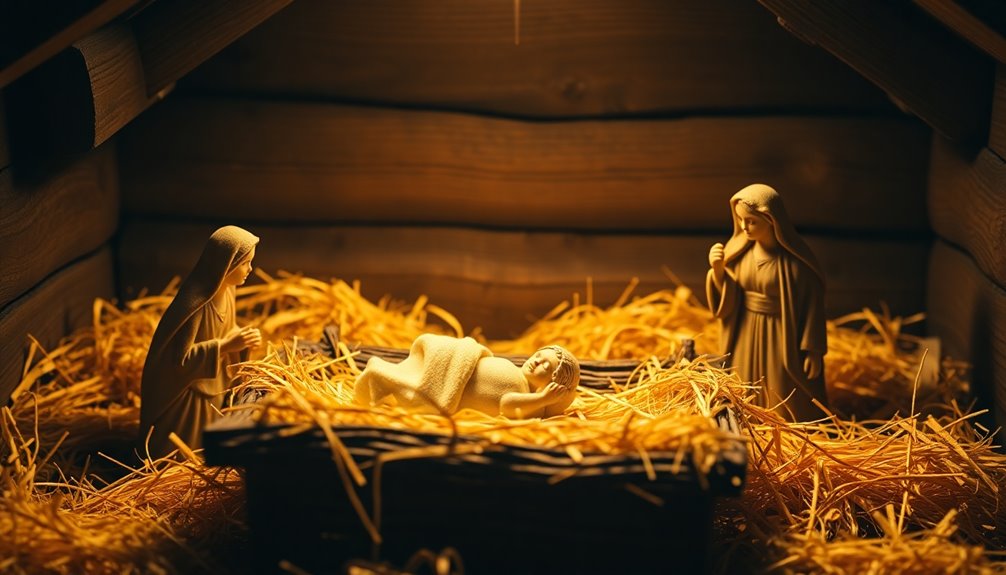
Symbolizing humility and divine love, the manger serves as a powerful reminder of Jesus' humble beginnings. This contrast between His lowly birth and divine nature has become a central theme in Christmas celebrations worldwide. Nativity scenes, popularized by St. Francis of Assisi, showcase the manger, emphasizing its significance as a symbol of accessibility. No matter your background or social status, the manger invites everyone to seek Jesus.
The cultural impact of the manger extends beyond religious settings. You'll find its imagery in various artistic representations and holiday traditions, reinforcing its role as a universal emblem of hope and humility during the Christmas season. Manger scenes often serve as teaching tools, helping both children and adults grasp the significance of Jesus' incarnation and His profound message of hope.
Moreover, the ongoing use of manger displays in church services and community gatherings highlights the importance of Jesus' birth in fostering kindness, generosity, and reflection during the holiday season.
Misunderstandings About the Nativity
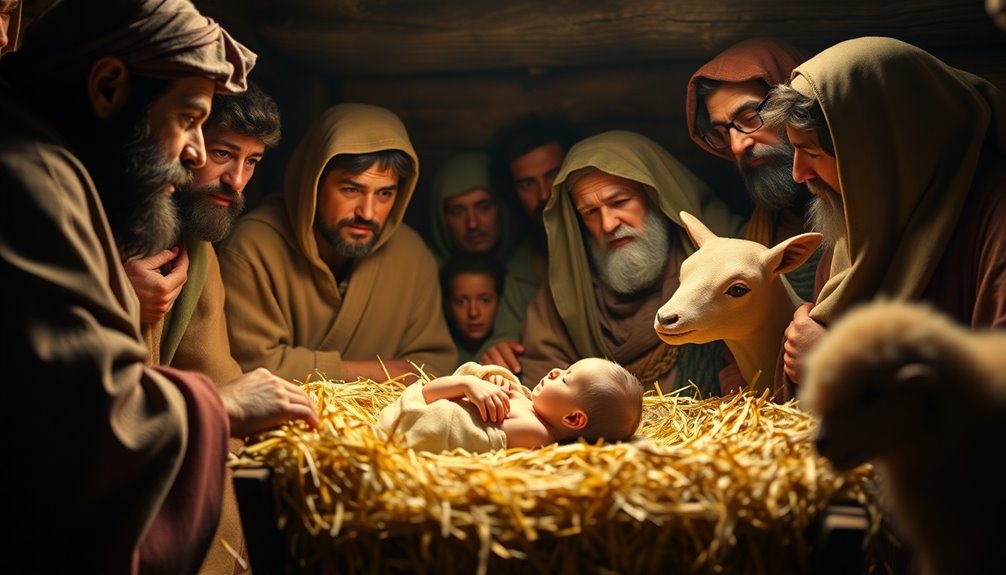
You might be surprised to learn that many common beliefs about the Nativity are actually misconceptions.
For example, the term "inn" in Luke 2:7 doesn't mean a hotel, and the manger probably wasn't made of wood.
Understanding these details can help clarify the historical accuracy of Jesus's birth story.
Debunk Common Nativity Misconceptions
Misunderstandings about the nativity often cloud the true story of Jesus's birth, leading many to envision a scene filled with inaccuracies. For instance, you might think Jesus was born in an inn, but the Gospel of Luke 2:7 reveals that Mary laid Him in a manger because there was no room in the "kataluma," likely a guest chamber in a relative's home.
Additionally, the traditional nativity scene often depicts a wooden manger, but historical evidence suggests it was actually a stone feeding trough, reflecting the humble setting of His birth. You might also picture farm animals nearby, yet the Gospels don't specifically mention their presence.
Another common misconception involves the shepherds, who are often shown at the nativity scene right after Jesus was born. In fact, according to the Gospel of Luke, they visited following the angelic announcement, suggesting they weren't there during the actual birth.
Lastly, while many nativity scenes feature three wise men, the Bible only tells us they brought three gifts—gold, frankincense, and myrrh—leaving their exact number uncertain.
Understanding these details helps clarify the real story behind the nativity.
Historical Accuracy of Nativity
The historical accuracy of the nativity story reveals a tapestry of details that often get lost in translation. You might find it interesting that the Gospels of Matthew and Luke present differing accounts of Jesus's birth. Matthew emphasizes the visit of the Magi, while Luke highlights the shepherds, reflecting each writer's unique audience and perspective.
Furthermore, when you read Luke 2:7, you'll see the term "inn" comes from the Greek "kataluma," which may actually refer to a guest room in a relative's home rather than a typical inn. This detail changes how you picture Joseph and Mary's situation.
Historical estimates suggest that Jesus was born between 6 BC and 4 BC, during King Herod's reign, providing a context to the nativity events.
It's also crucial to remember that the manger, a feeding trough, symbolizes Jesus's humble beginnings, contrasting sharply with expectations of a royal birth.
Finally, the nativity scene popularized in art often embellishes these biblical details, leading to misconceptions about the circumstances of Jesus's birth, such as the presence of animals or figures not mentioned in the Gospels.
Community Service Inspired by Humility

When you think about Jesus' humble beginnings in a manger, it's a powerful reminder of the importance of simplicity in our lives.
This spirit of humility can inspire you to engage in community service projects that truly make a difference.
Embracing Simplicity in Life
Embracing simplicity in life can transform not just your perspective but also the lives of those around you. The humble birth of Jesus in a manger exemplifies the value of humility and encourages you to adopt a lifestyle centered on service.
By engaging in community service and performing charitable acts, you reflect the spirit of Jesus' lowly beginnings, fostering a genuine connection with those in need.
When you prioritize simplicity, you recognize the importance of supporting marginalized communities. Volunteering at shelters or food banks not only aids those who are struggling but also enhances your well-being and happiness.
Research shows that acts of kindness can give you a sense of purpose and fulfillment, enriching your own life as you uplift others. Additionally, practicing mindfulness techniques can help you remain grounded and focused on the present while serving.
As the Christmas season approaches, consider how the tradition of giving can extend beyond material gifts. By focusing on the essence of Jesus' birth, you can find joy in serving others.
Embrace simplicity, and let it guide you toward a life filled with meaningful connections and impactful service, ultimately creating a ripple effect of kindness in your community.
Service Projects Reflecting Humility
During this holiday season, engaging in service projects that reflect humility can deepen your connection to the spirit of Jesus' birth. You might consider organizing food drives to gather non-perishable items for local food banks, ensuring that those in need receive both spiritual and physical nourishment.
Volunteering at shelters or soup kitchens also embodies the essence of humility, providing direct support to those less fortunate.
Creating care packages for the homeless, filled with essentials like blankets, toiletries, and warm clothing, mirrors the simplicity of the manger experience. Participating in community clean-up events promotes stewardship, allowing you to care for your environment and reflect on Jesus' lowly origins.
Additionally, hosting outreach programs that offer tutoring or mentoring to underprivileged youth emphasizes the importance of accessibility and education, core themes of Jesus' message.
Each of these community service projects allows you to embody humility, echoing the example set by Jesus. By dedicating your time and resources, you not only honor the spirit of His birth but also make a meaningful impact within your community.
Manger's Role in Humility
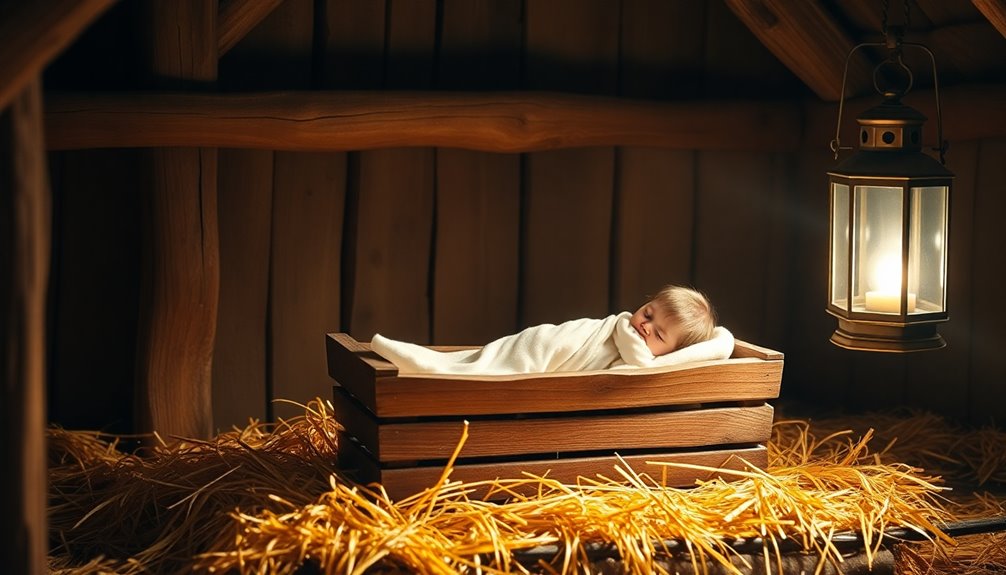
The manger stands as a powerful symbol of humility in the nativity story, showcasing the stark contrast between Jesus' divine origins and His humble beginnings. Laid in a manger due to a lack of space at the inn, Jesus' birth emphasizes the humility of His entrance into the world as the Messiah.
Mangers, typically found in stables and used for feeding animals, reflect the rustic and poor surroundings that accompanied His arrival, highlighting His identification with the marginalized.
The significance of the manger extends beyond its physical form. Elevated off the ground, it not only provided safety for the newborn Jesus but also serves as a metaphor for spiritual nourishment. Jesus is referred to as the "Bread of Life," inviting you to find sustenance in His teachings.
This humble setting encourages you to reflect on the importance of humility in faith. The accessibility of Jesus to all, regardless of societal status, is a core message of the nativity.
Additional Resources

Exploring the nativity story further can deepen your understanding of the significance of the manger and its symbolism. To enrich your knowledge, consider reading biblical passages like Luke 2:7 and Micah 5:2, which highlight the humble origins of the infant Jesus. These verses reveal how the manger, a simple feeding trough, underscores His accessibility to all.
You might also explore the role of the manger in Christian holidays, particularly during Christmas. Understanding the Nativity displays that depict this scene can enhance your appreciation of how St. Francis of Assisi popularized this tradition in the 13th century.
Additionally, look into the prophecies surrounding Jesus' birth, which emphasize hope and salvation for humanity. Reflect on the first visitors, the shepherds, who were chosen to witness this miraculous event, reminding us that divine messages often reach the humble and marginalized.
For spiritual nourishment, consider devotionals that focus on the themes of the manger and its broader implications in your faith journey. Engaging with these resources can deepen your connection to the message of the nativity and the significance of Jesus as the "Bread of Life."
Frequently Asked Questions
Why Was Jesus Placed in a Manger?
You might wonder why someone would be placed in a manger. It typically symbolizes humility and accessibility, which can be significant traits.
Where in the Bible Does It Talk About Jesus in the Manger?
You'll find the account of a significant event involving a manger in the Gospel of Luke, specifically in chapter 2.
It details how Mary wrapped her newborn son in swaddling cloths and laid Him in a manger because there wasn't any room at the inn.
This humble setting highlights the profound nature of His birth, making it a pivotal moment in the New Testament narrative.
Be sure to check Luke 2:7 for the full context!
What Does the Manger Symbolize?
The manger symbolizes humility and simplicity, reminding you of the importance of being grounded in your faith.
It serves as a feeding trough, representing spiritual nourishment that you can find in teachings that promote love and compassion.
This imagery highlights God's accessibility, inviting you to embrace vulnerability and seek a deeper connection with your spirituality.
Ultimately, the manger encourages you to reflect on your own journey toward simplicity and fulfillment in life.
What Lesson Do We Learn From Jesus Born in Manger?
You learn that true greatness often lies in humility and simplicity.
When you embrace a lowly beginning, you realize that wealth and status aren't what define you.
Instead, it's about serving others and connecting with those who are marginalized.
This lesson encourages you to seek spiritual nourishment and be open to vulnerability, reminding you that your actions matter more than your circumstances.
Embrace humility, and you'll find deeper meaning in your life.



